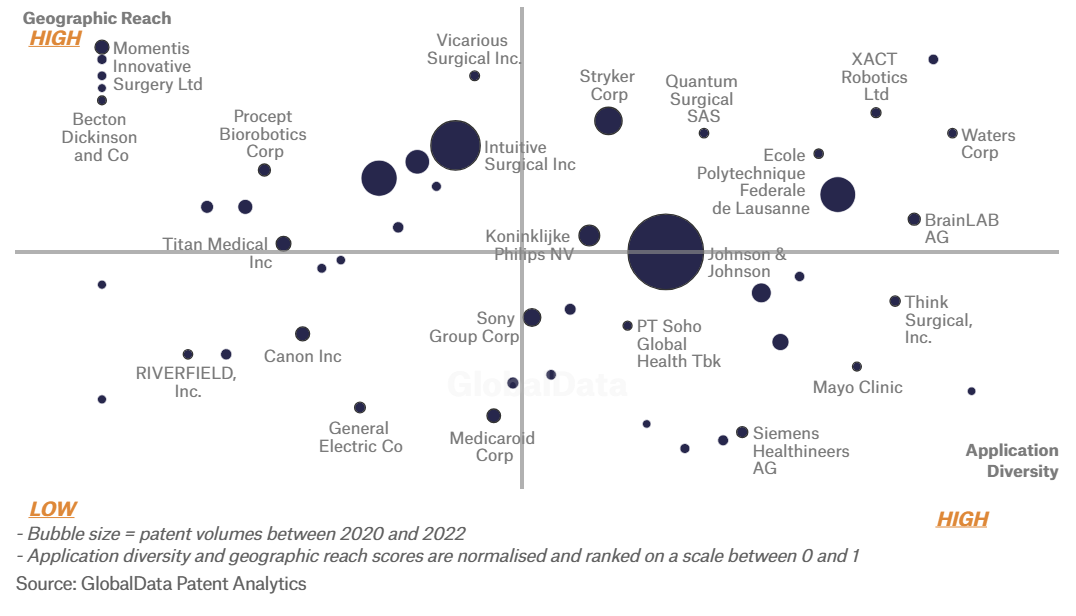The medical devices industry continues to be a hotbed of patent innovation. Activity is driven by increased need for homecare, preventative treatments, early diagnosis, reducing patient recovery times and improving outcomes, as well as a growing importance in technologies such as machine learning, augmented reality, 5G and digitalization.
In the last three years alone, there have been over 710,000 patents filed and granted in the medical devices industry, according to GlobalData’s report on Robotics in medical: surgical robots.
According to GlobalData’s Technology Foresights, which uses over 487,000 patents to analyse innovation intensity for the medical devices industry, there are 120+ innovation areas that will shape the future of the industry.
Surgical robots is a key innovation area in robotics
Surgical robots automate all or part of the medical surgery process. Surgical robots are designed to solve the limitations currently present in minimally invasive surgeries (MIS), as well as to improve outcomes in open surgical procedures. These systems are utilized in a variety of surgical procedures, including cardiovascular, general surgery, orthopaedic, neurosurgery, obstetrics, and gynaecology.
GlobalData’s analysis also uncovers the companies at the forefront of each innovation area and assesses the potential reach and impact of their patenting activity across different applications and geographies.
According to GlobalData, there are 200+ companies, spanning technology vendors, established medical devices companies, and up-and-coming start-ups engaged in the development and application of surgical robots.
Key players in surgical robots – a disruptive innovation in the medical devices industry

‘Application diversity’ measures the number of applications identified for each patent. It broadly splits companies into either ‘niche’ or ‘diversified’ innovators.
‘‘Geographic reach’ refers to the number of countries each patent is registered in. It reflects the breadth of geographic application intended, ranging from ‘global’ to ‘local’.
Patent volumes related to surgical robots
Intuitive Surgical is one of the leading patent filers in the field of surgical robots. Some other key patent filers in the field include Johnson & Johnson, Medtronic, and Olympus.
In terms of application diversity, Bonutti Skeletal Innovations leads the pack, followed by Waters and DEKA Research and Development. By geographic reach, Momentis Innovative Surgery holds the top position, followed by DEKA Research and Development and European Commission in second and third spots, respectively.
The segment’s prevalence is increasing, evidenced by Intuitive Surgical’s daVinci system that is known to have performed more than ten million procedures since its launch, leading to a significant investment in medical robotics.
Surgical robots are expected to have far-reaching implications in the field of surgery as they offer minimally invasive procedures that present fewer complications with a shorter recovery time. The surgical robot market is expected to grow at a lucrative rate driven by the acceptance from medical fraternity and patients at large, and by the increasing demand for automation to meet the treatment needs of ever-growing population suffering from urological, neurological, and gynaecological, and other diseases.
To further understand how robotics is disrupting the medical devices industry, access GlobalData’s latest thematic research report on Robotics in Medical Devices.
GlobalData, the leading provider of industry intelligence, provided the underlying data, research, and analysis used to produce this article.
GlobalData’s Patent Analytics tracks patent filings and grants from official offices around the world. Textual analysis and official patent classifications are used to group patents into key thematic areas and link them to specific companies across the world’s largest industries.